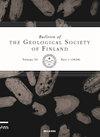Editorial: LiDAR – rapid developments in remote sensing of geological features
IF 1.3
4区 地球科学
Q2 GEOLOGY
引用次数: 3
Abstract
LiDAR-based (Light Detection And Ranging) 2 m-grid digital elevation models (DEM) are exceptional remote sensing data in geosciences in many aspects: they can be used to constrain terrain features in greater detail than ever before (Johnson et al., 2015), allow extraction of new geomorphological features and relationships (Mäkinen et al., 2017), provide a possibility of acquiring 3D information of the terrain, and nowadays cover extensive areas in Finland (ca. 90%), and elsewhere in the Fennoscandian Shield. LiDAR DEMs open up new ways of investigating and modelling of geological processes and geomorphological characteristics, and thus provide significant potential for advancing theories in geosciences. In Scandinavia, high-resolution LiDAR imagery has so far been employed to study and map a wide range of glacial geomorphology and postglacial terrain features. These include research on issues such as ribbed (Rogen) and hummock moraines and their tracks and corridors (Möller and Dowling, 2015; Peterson et al., 2017), ice streaming (Greenwood et al., 2015), De Geer moraines (Bouvier et al., 2015; Ojala et al., 2015; Ojala 2016), subglacial meltwater systems (Sarala et al., 2015), beach ridges, cliffs and shore terraces (Ojala et al., 2013), fluvial terraces, floods plains and lateral meltwater channels (Eilertsen et al., 2015), Bulletin of the Geological Society of Finland, Vol. 89, 2017, pp 61–63, https://doi.org/10.17741/bgsf/89.2.ed编辑:激光雷达——地质特征遥感的快速发展
基于激光雷达(lidar)的2米网格数字高程模型(DEM)在地球科学的许多方面都是特殊的遥感数据:它们可用于比以往更详细地约束地形特征(Johnson et al., 2015),允许提取新的地貌特征和关系(Mäkinen et al., 2017),提供获取地形3D信息的可能性,如今覆盖了芬兰(约90%)的广大地区,以及芬诺斯坎地盾的其他地方。激光雷达dem开辟了研究和模拟地质过程和地貌特征的新途径,从而为推进地球科学理论提供了巨大的潜力。在斯堪的纳维亚半岛,高分辨率激光雷达图像迄今已被用于研究和绘制广泛的冰川地貌和冰川后地形特征。其中包括对肋状(罗根)和丘状冰碛及其轨迹和走廊等问题的研究(Möller和Dowling, 2015;Peterson等人,2017),冰流(Greenwood等人,2015),De Geer moraines (Bouvier等人,2015;Ojala et al., 2015;Ojala 2016),冰下融水系统(Sarala等人,2015),海滩山脊,悬崖和海岸阶地(Ojala等人,2013),河流阶地,洪泛平原和侧向融水通道(Eilertsen等人,2015),芬兰地质学会公报,2017年第89卷,61-63页,https://doi.org/10.17741/bgsf/89.2.ed
本文章由计算机程序翻译,如有差异,请以英文原文为准。
求助全文
约1分钟内获得全文
求助全文
来源期刊
CiteScore
1.30
自引率
0.00%
发文量
5
审稿时长
>12 weeks
期刊介绍:
Bulletin of the Geological Society of Finland (BGSF) publishes research articles and short communications in all branches of geosciences. Contributions from outside Finland are welcome, provided that they contain material relevant to Finnish geology or are of general interest.

 求助内容:
求助内容: 应助结果提醒方式:
应助结果提醒方式:


